|
Physiology ECG Revision Why and How |
||
|
Why?
Based on feedback from clinics, who uniformly complain about substantial lack of knowledge of ECG by medics it was suggested that more attention is drawn to this issue. Medical Physiology course covers the topic extensively (lecture, lab). Further, a compulsoru-eligible subject is offered. As a routine part of practical exam in Physiology Final everyboody will be required to describe one ECG curve. We believe that this will result in: more thorough revision, better retention of knowledge, improved clinical skills before getting to clinics and more. The aim of this revision is that 2nd year students demonstrate their basic knowledge of ECG analysis, i.e.: rate, regularity, rhythm, AV conduction and axis. Aditionally students are required to distinguish whether PQRST morphology is normal or not. It is expected that 10 minutes is more than enough to describe the curve as required. Majority of the exam curves are not physiological. However, there is no difference in determining rate, regularity, conduction and axis comapred to physiological electrocardiogram. Thus it should not be objected that electrograms include also pathologies.
How?
Besides studying principles of ECG (see lectures, lab notes, internet) pay extra attention to practical application, i.e. how to read real curves.
|
||
|
In general: |
It is expected: |
It is NOT expected: |
|
|
- Understanding basics of ECG |
- Just memorizing some ECG curves |
|
|
|
|
|
Required description: |
what is required |
how |
|
Rhytm |
sinus /not sinus |
This may the be hardest part!
|
|
Regularity |
regular /irreg |
|
|
Rate |
pls calculate[bpm] |
|
|
PQ interval |
PQ or PR duration [ms] |
|
|
Axis |
degrees or semiquantitative |
|
|
P-QRS-T |
is all normal? yes/no |
e.g. aVR, V1.
|
| if abnormal, say what is not normal. e.g.: wide QRS in V1-V6 |
|
|
| Note: | paper speed 25mm/s 10mm = 1 mV |
|
Click on the picture below to see one of the examples of ECG taken on exam




